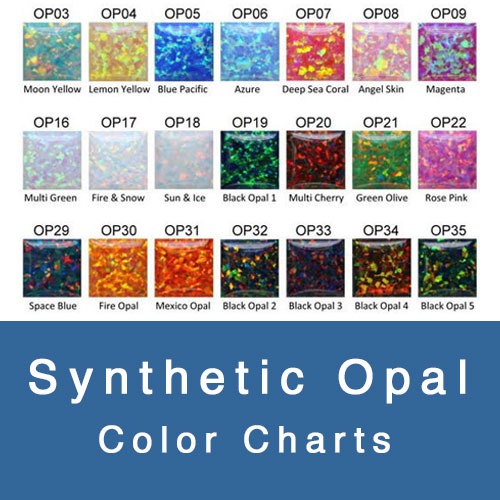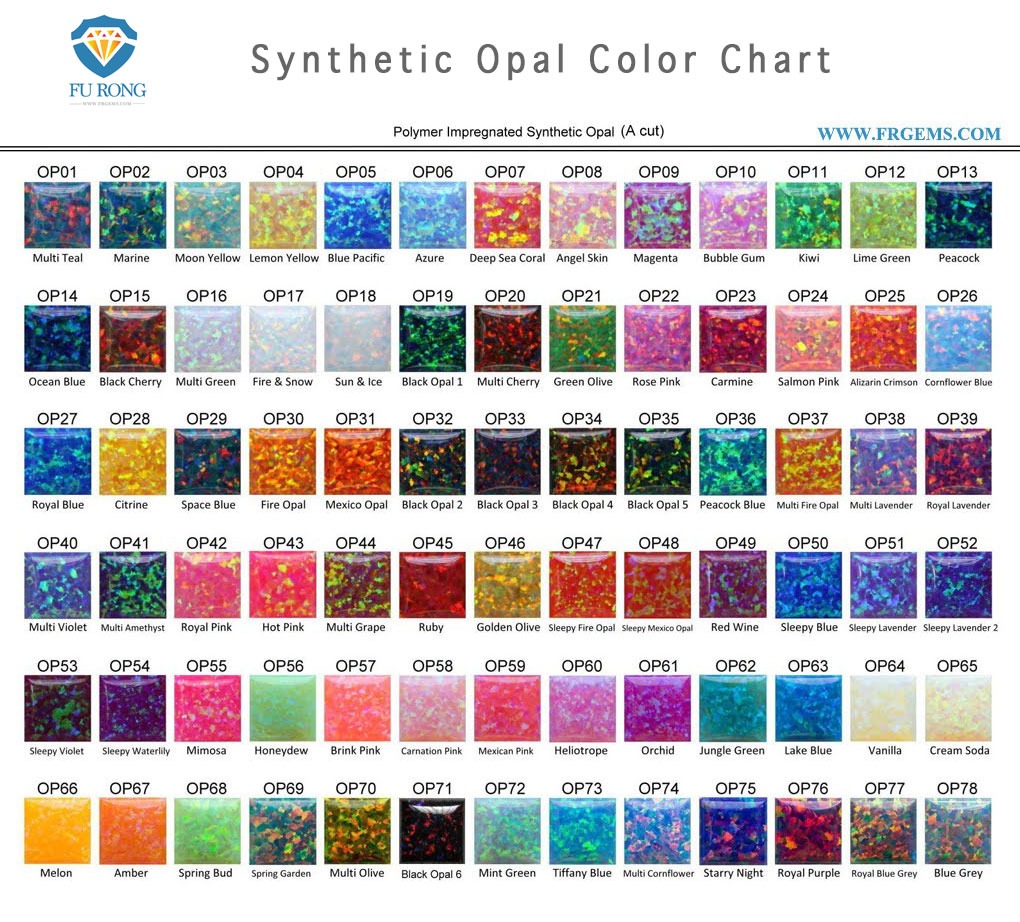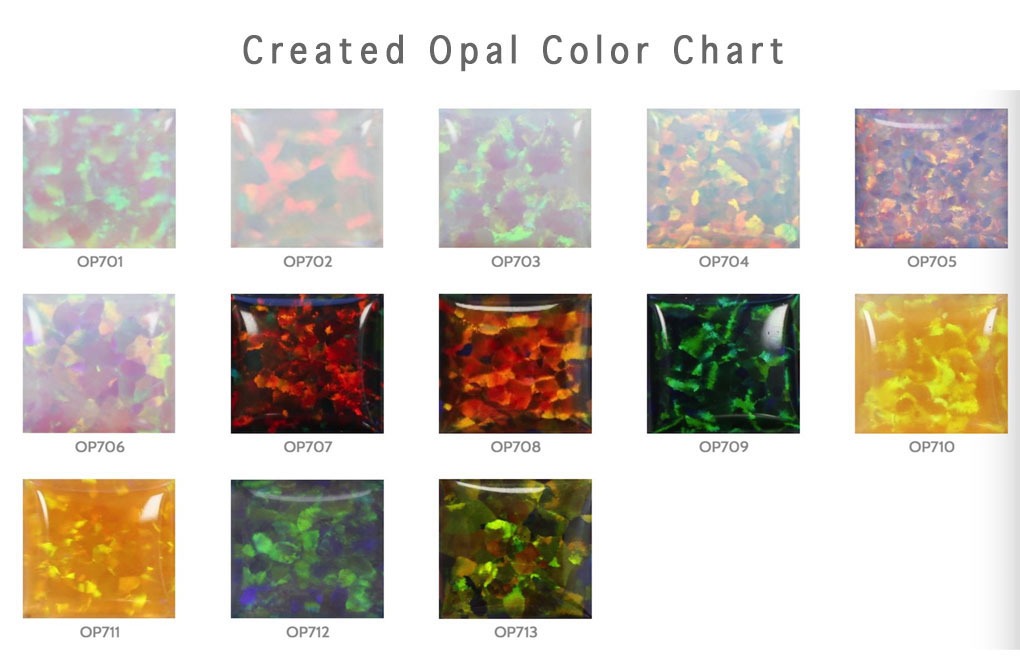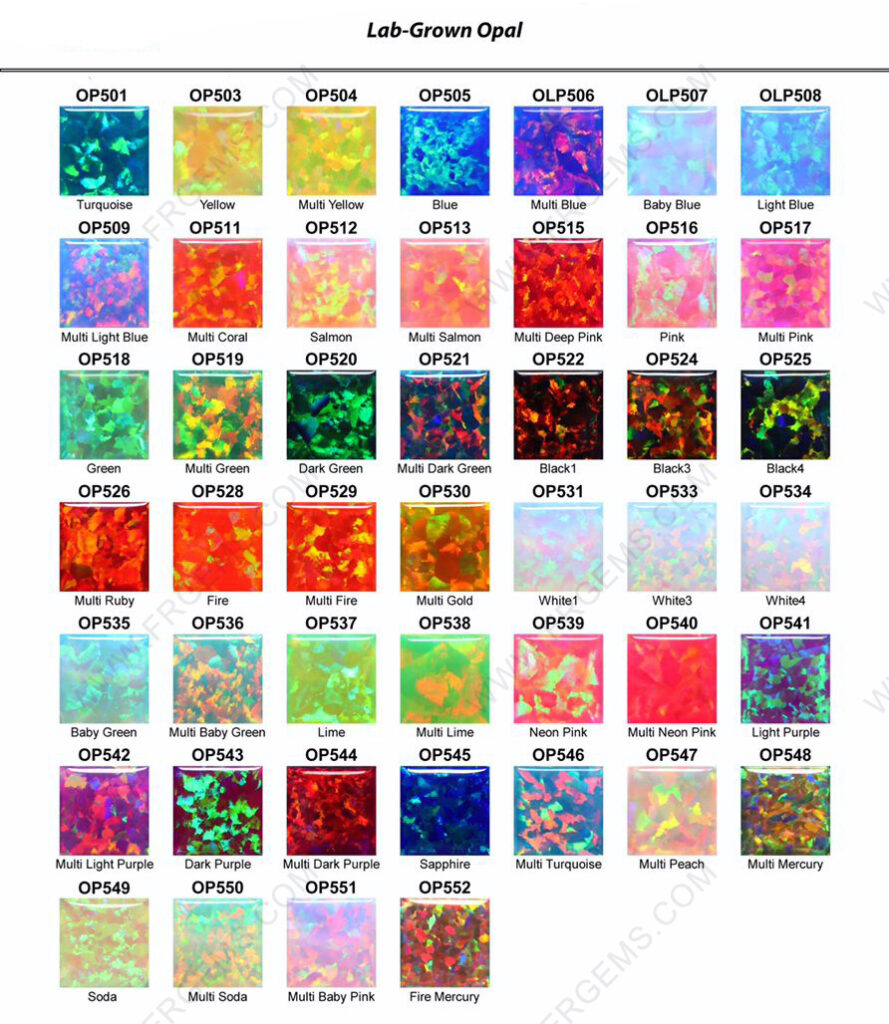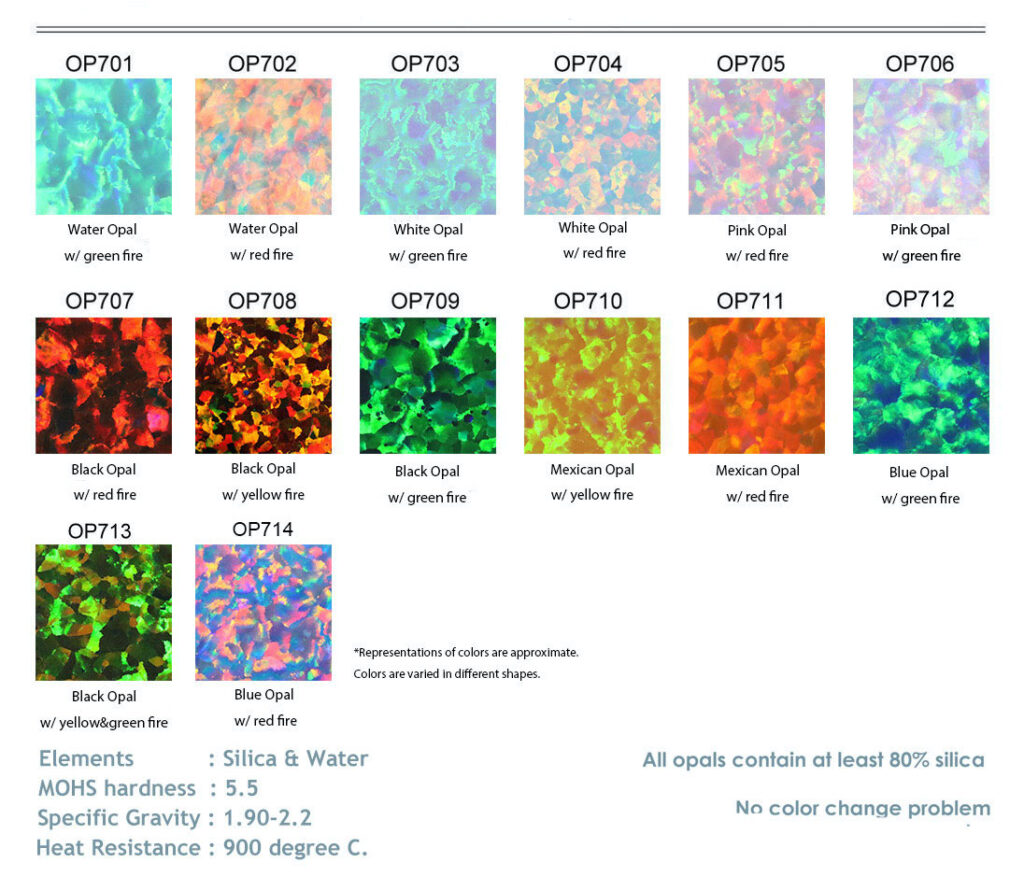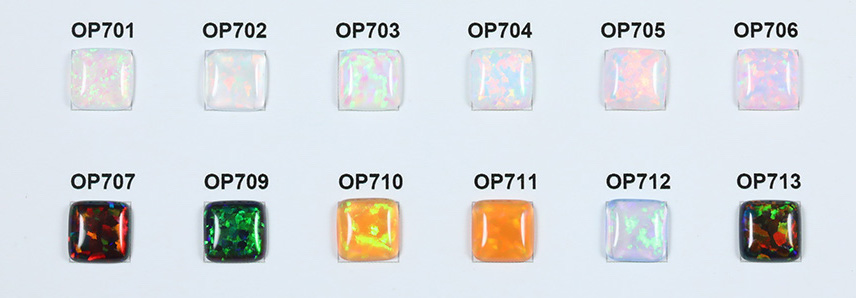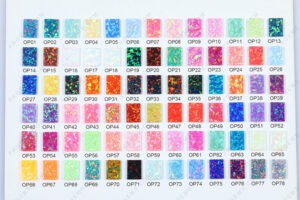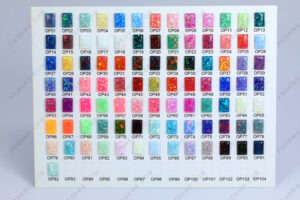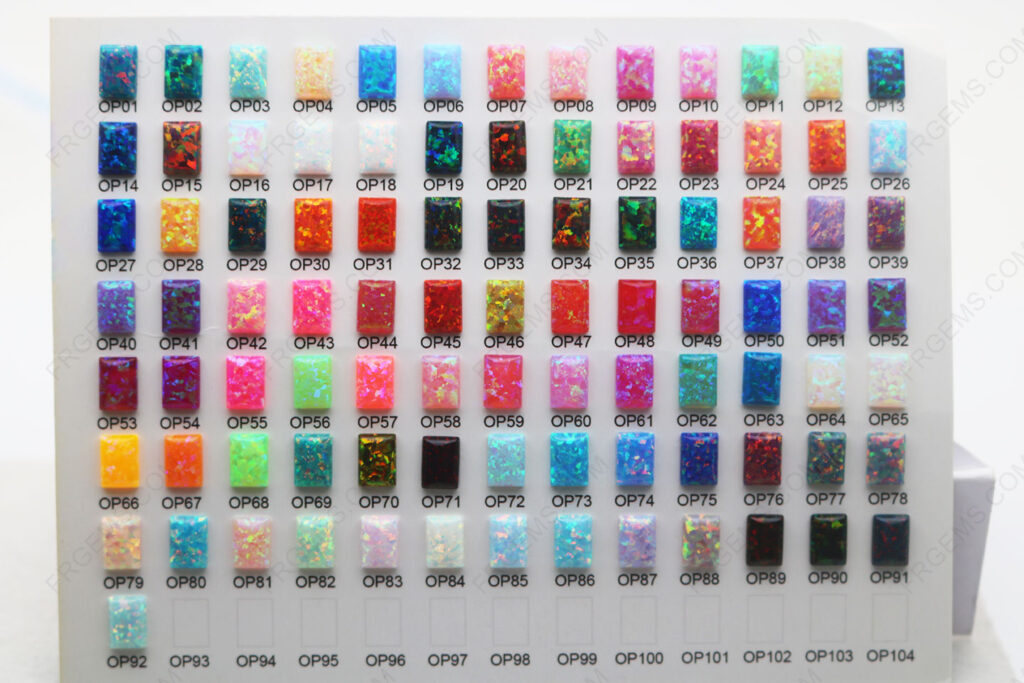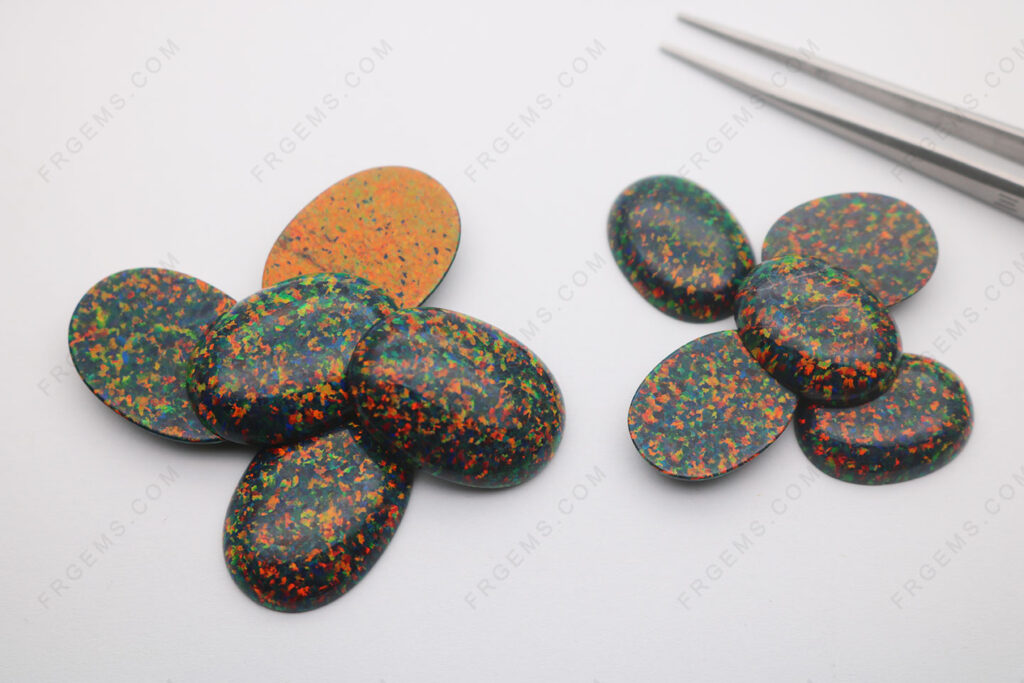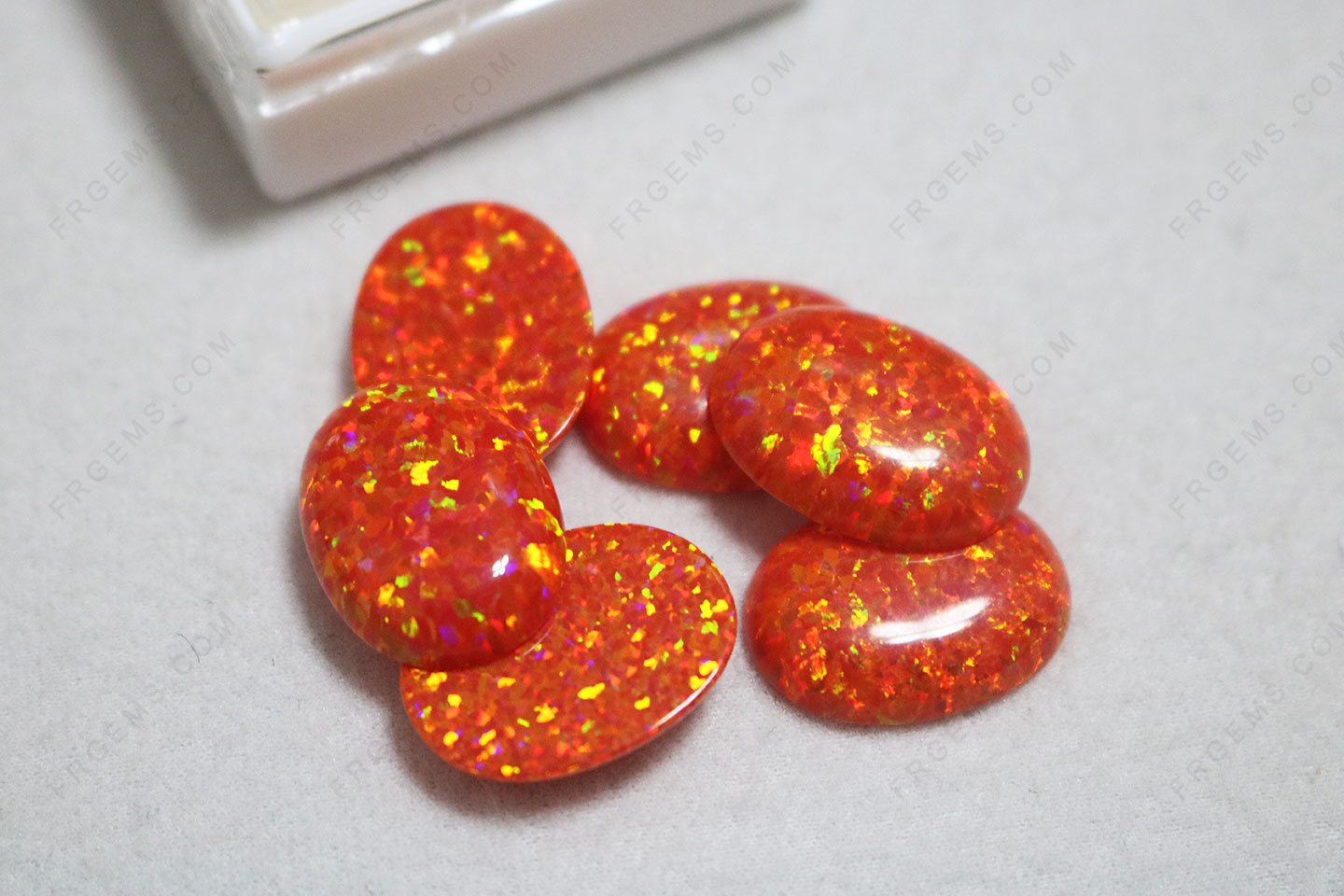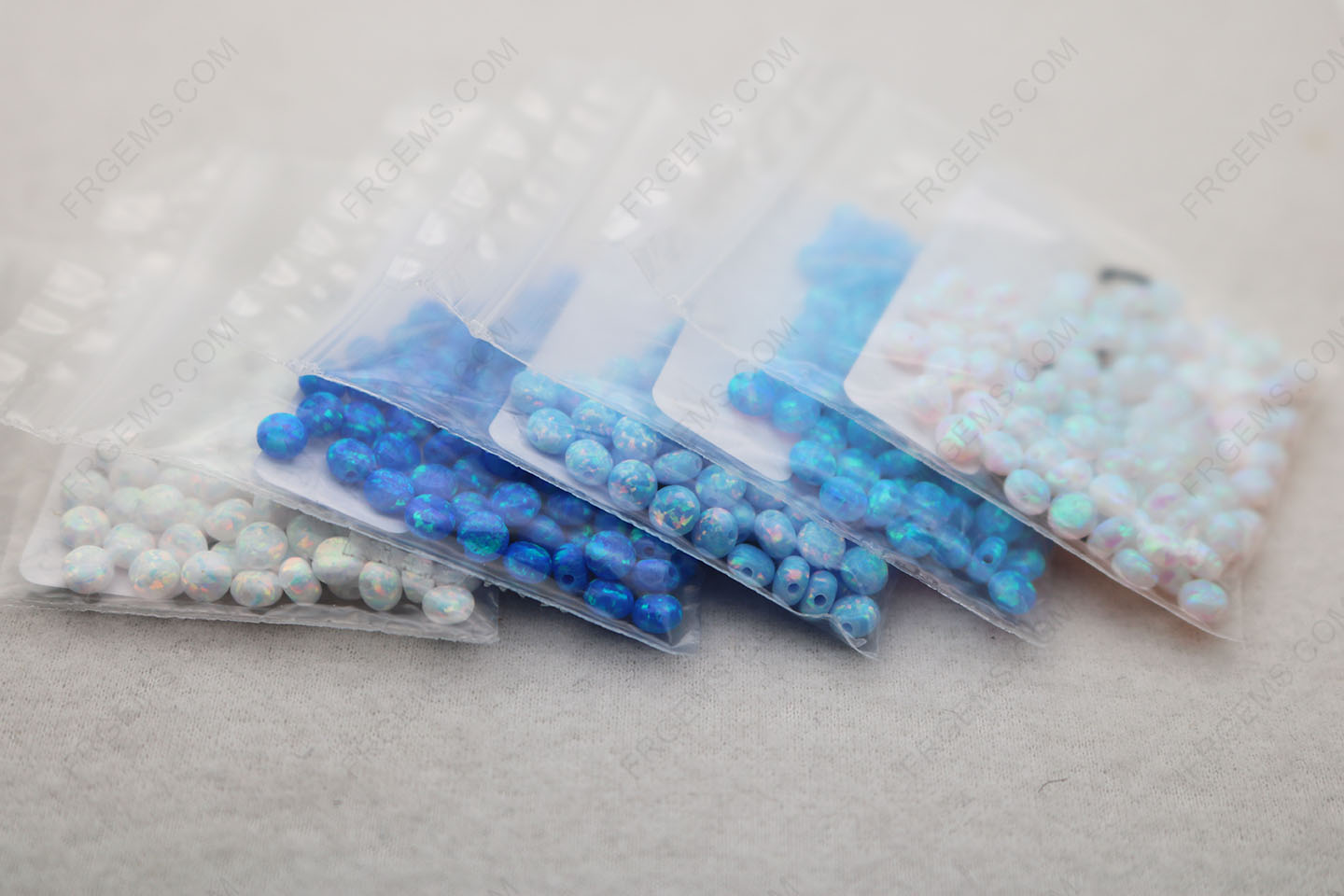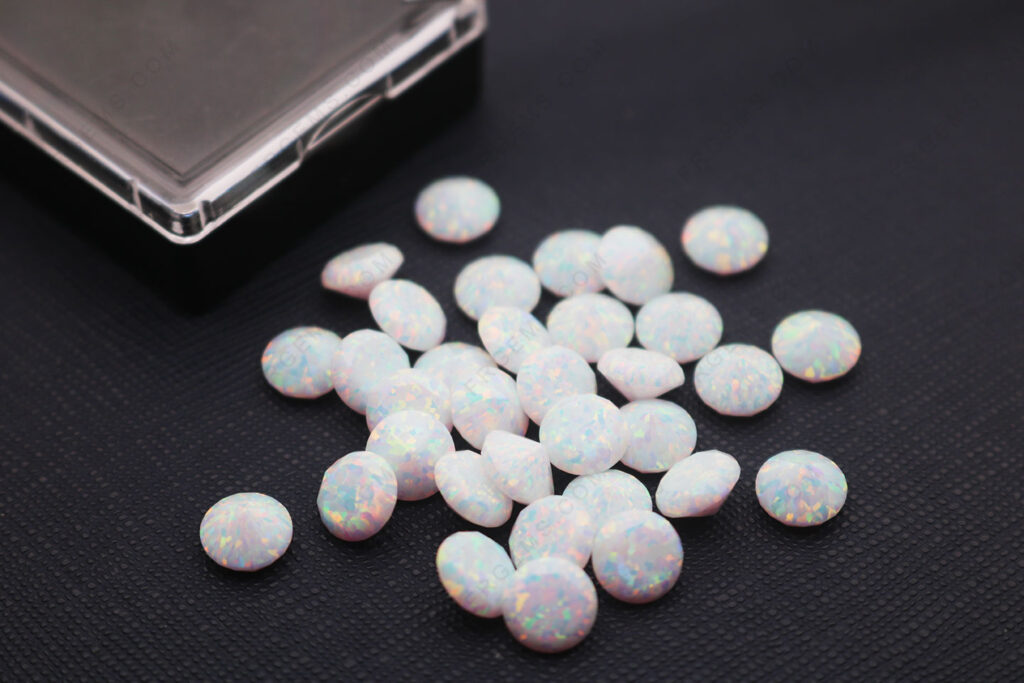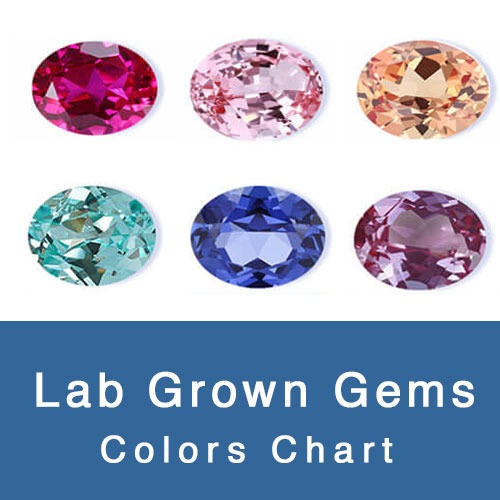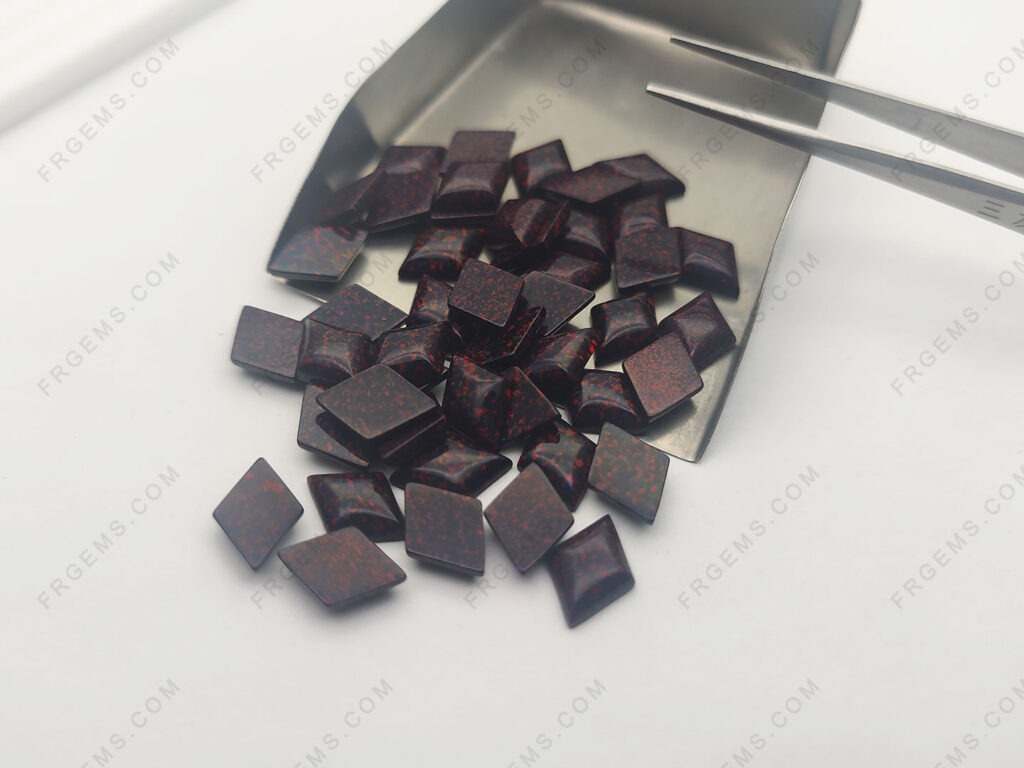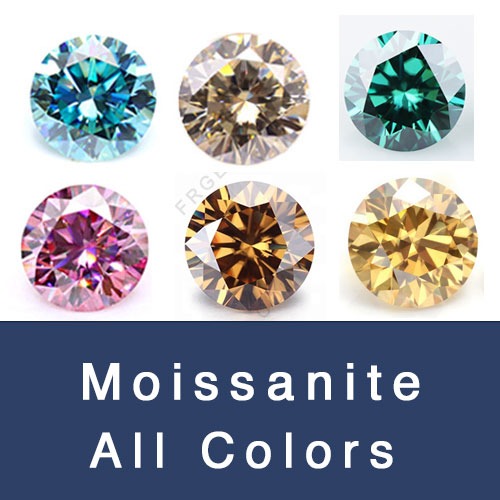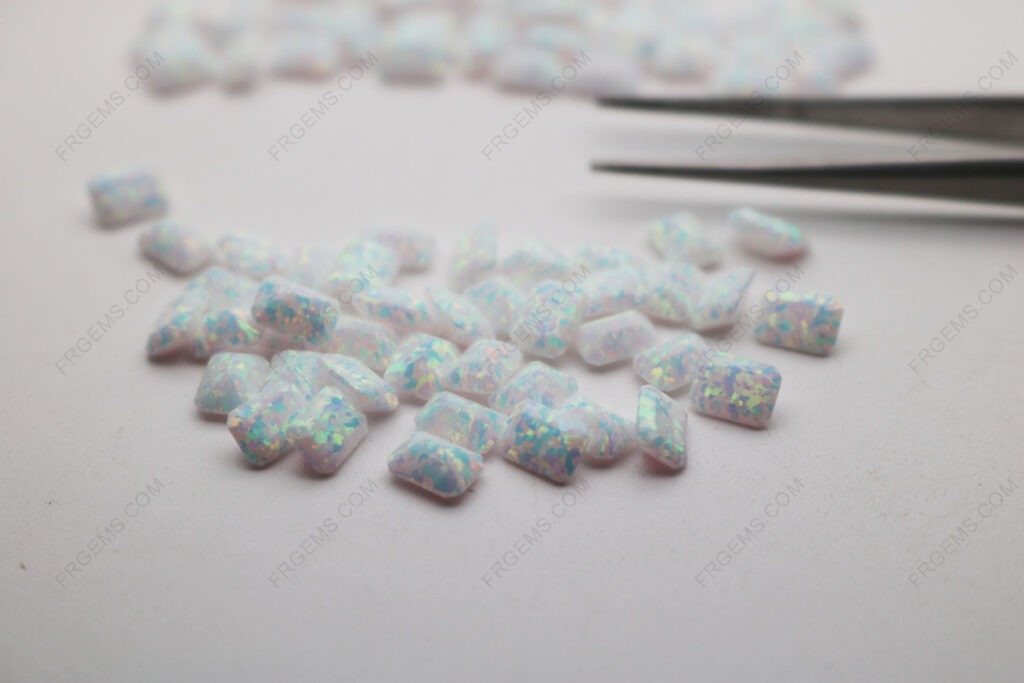There're 3 kinds of 'Synthetic Opal' stones:
One is Polymer Impregnated Synthetic Opal: This is original collection. have 92 colors
2nd is Lab grown Opal : It Shows translucent color and bigger scale of fire pattern.
3nd is Created Opal:
Polymer Impregnated Synthetic Opal is composed by 80% silica & 20% resin. It is available in 92 different colors, such as green opal, blue opal, white opal, pink opal, yellow opal, purple opal, black opal…etc. It is widely used in different product markets such as jewelry, watches, eyewear and other accessories. Lab-grown impregnated synthetic opal)is available in vast selection of designs. If you have new idea of application, please contact with FU RONG Sales Team and will propose the best solution for your projects.
SYNTHETIC OPAL COLOR CHART


Lab Grown OPAL COLOR CHART -2024 Latest
Lab grown Opals has the same composition as the original collection. But It has a more translucent colour for light colour opal, such as white opal, light blue opal, light green opal, light pink opal…etc. and It shows translucent color and bigger scale of fire pattern. It is available in 52 different colours.Lab Grown opal series is reminiscent of the beautiful natural opal.
CREATED OPAL COLOR CHART -2024 Latest fires
Galaxy Collection (Mineral Type Created Opal) is composed by silica & very small portion of water. It is the only glass compatible opal among three collections. You may also call it “Galaxy Opal or Created Opal”. It is available in 14 opal colours, such as water opal, milky opal, black opal, blue opal, pink opal and fire opal.
Due to the transparency of some colors, such as OP701, 702, 712 etc, the colors are slightly different in various shapes and sizes.

Synthetic Opal Gemstones Color chart for sell: US$60
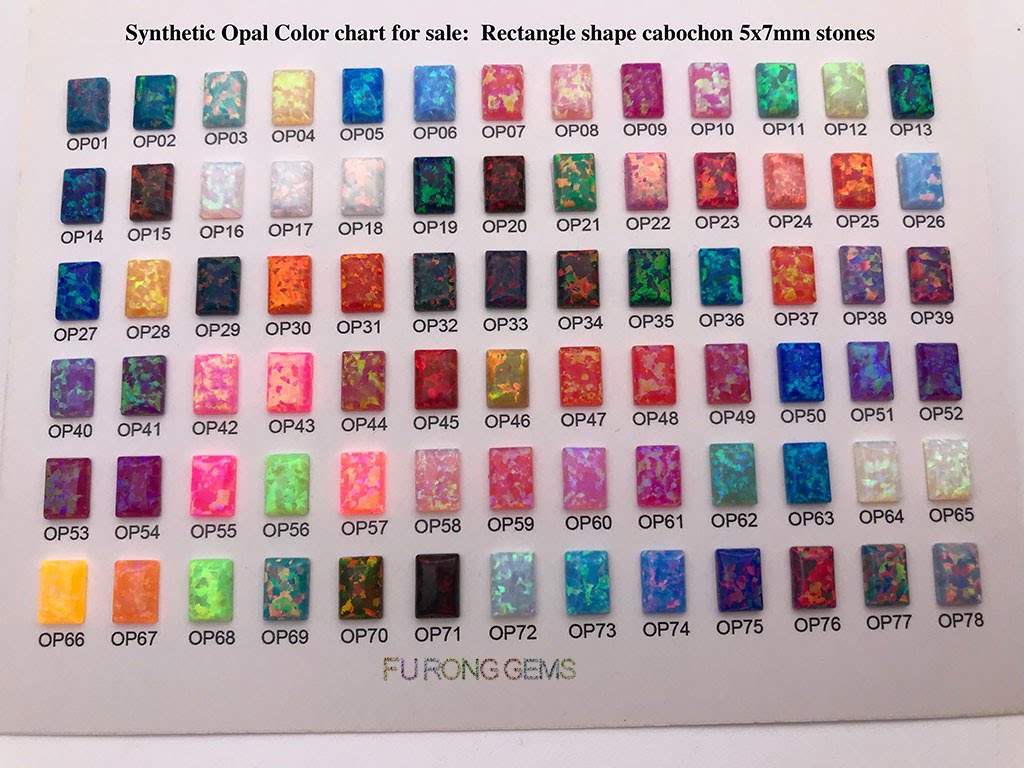
There're 2 colors charts for sell, one is with 78 colors, another is with 92 colors
78 colors: $60
92 colors: $80
|
|
10 things about the Synthetic and Created OPAL stones
1) What is Synthetic Opal? And what is imitation opal?
Imitation opal is what people usually consider fake opal. It could be made of a material that resembles the appearance of opal but has different chemical and physical properties. They could be either plastic, glass or any other materials…etc.
Opal-like Plastic (OLP) is certified by GIA as imitation opal. It is a man-made opal which contains 80% resin and 20% silica. It is also a heat-hardened of resin with mixture of silica in short period of time. Due to their formation feature, it is also named as "Resin Colloidal Imitation Opal". Some people mistakenly call OLP as synthetic opal. To clarify again, OLP is a plastic material with some color change effect.
Glass Opalite is a commonly known imitation opal. It does not show any play of color and is simulating common opal. It is merely glass.
Reminder: Keep in mind that not all man-made opals are of the same quality. High-quality ones can be tens of times as expensive as low-quality gemstones.
2) What makes a man-made opal qualified as "Synthetic Opal"?
According to GIA, synthetic opal must:
(a) be silica in composition (major elements), possibly containing some water;
(b) be composed of submicroscopic spheres;
(c) have gemological properties with refractive index (RI) between 1.37 and 1.47
FU RONG's Opal & Galaxy Opal, composing of orderly arrays of silica, are both certified by GIA as synthetic opal while the latter one is chemically identical to natural opal. To clearly distinguish the difference between two products, GIA named Opal, the one with 20% resin, as "Polymer Impregnated Synthetic Opal" and Galaxy Opal as "Synthetic opal".
Photo4: Synthetic opals - FU RONG Opal & Galaxy Opal
3)What is "Created Opal"?
"Created opal" is sometimes used by marketers to describe synthetic opal which is chemically identical to natural opal. Although created opal and synthetic opal have been used interchangeably by marketer, it is important for jewelers to understand that created opal is specially referring to resin free opal as this may affect their handling conditions. Resin free created opal is suitable for setting in wax or glassblowing.
Galaxy Opal which only contains silica &small portion of water is the best example of created opal as they are resin free.
4)Why is lab-grown opal unique?
Only synthetic opal goes through lab-grown process could be named as lab-grown opal. It is not only a process which takes time but a combination of technology and craftsmanship in creating unique columnar structure for synthetic opal. Columnar structure which looks like vertical fire, is also representing the growth pattern of lab-grown opal, resembling natural opal's precious play of colors. This professionalism endows the opal the precious value while this vertical fire is the key feature to distinguish lab-grown opal from the others.
FURONG Opal and Galaxy Opal with the unique vertical fire are good examples of lab-growth synthetic opal. Opal-like Plastic (OLP) is not lab-grown opal as they are basically a heat-hardened of resin with mixture of silica. Their fire pattern is non-directional and without vertical fire.
4)Opals found in thin fractures in basalt from Honduras commonly show pronounced banding that marks the horizontal level. Play-of-color bands have a vertical, columnar shape that corresponds to digit pattern development.
Source from: https://www.gia.edu/gems-gemology/FA13-opal-digit-patterns-rondeau
5)Misuse of the term "Polymer impregnated" and "Lab-created".
"Polymer impregnated" is used to describe a synthetic opal which go through the resin impregnation process and this process could only take place if solid stone is ready in advance.
Opal-like Plastic (OLP) is mistakenly advertised as impregnated opal by some amateurs. The formation of OLP is by mixture of plastic with silica, thus, it is impossible for the impregnation process to take place
"Lab-created" can only be using as description for synthetic opal. Marketers may use lab-grown opal or lab-created opal for their advertisement for synthetic opal products.
However, some amateurs advertised Opal-like Plastic (OLP) as lab-created opal. According to GIA , the comment "This is man-made opal and has been produced in laboratory" only applies for synthetic opal. The properties of the OLP match with Plastic, it is not a synthetic opal, that's why they don't put this comment in report.
6)How does the value vary among different man-made opals?
Synthetic opal (Resin free) has the highest value among all as it is chemically identical to natural opal. Polymer impregnated synthetic opal is a high-quality option with relatively lower price, at the same time carrying the unique feature of vertical fire.
Within the imitation opal category, the price range could vary a lot as there are different material options, some are merely glass or plastic.
Table 2: Quick overview of their value ranking
Category Academic name Example: Composed by: Value ranking
Synthetic Opal (Resin free) Mineral Type Synthetic Opal FURONG Opal® - Galaxy Opal Silica & water 1
Synthetic Opal Polymer Impregnated Synthetic Opal FURONG Opal® 80% silica & 20% resin 2
Imitation Opal Resin Colloidal Imitation Opal Opal-like Plastic (OLP) 20% silica & 80% resin 3
Opalescent Glass Glass Opalite Glass 4
*Remark: Value 1 as highest, 4 as lowest.
7) How crucial is it to choose the right lab-grown synthetic opal manufacturer?
Synthetic opal stands for higher quality than other man-made opal. However, their quality may still vary among different manufacturers as they may have different quality control procedures and using different raw materials.
Synthetic Opal (Resin free):
Gilson is the first company who successfully invented resin free synthetic opal and Gilson Opal is commonly known as created opal in the market. Nowadays, Gilson Opal is no longer available with any new production and those selling in market right now are the old stock. You may ask about the origin of material when you purchase resin free synthetic opal. Sometimes people still selling different types of opals with the name of "Gilson Opal", even for the polymer impregnated synthetic opal.
Synthetic Opal:
KYOCERA Corporation, Forbes Top Regarded Company, is the first company who invented the polymer impregnated synthetic opal. With its exceptional quality, it has become the mainstream gemstone in the man-made opal market. FURONG Opal material is made by Kyocera.
Reminder: Some dishonest companies have been selling unauthorized synthetic opal with the brand of Kyocera Opal. Physically the cut opal stone only looks similar to Opal-like Plastic (OLP) and in fact there isn't even material safety data sheet (MSDS) as what Kyocera Opal has. Their quality and value are questionable. Moreover, OP01 to OP78 is the official color code for FURONG Opal and these codes have been frequently appropriated by dishonest companies too.
7) Which man-made opal is glass compatible?
If you are looking for opal which is glass compatible, resin free synthetic opal is your best and only option. Even natural opal cannot withstand high temperature which is required in glassblowing.
Gilson Opal and Galaxy Opal are both glass compatible.
8) Which man-made opal could work well with jewelry plating?
All resin free synthetic opal can work well with jewelry plating. However, not all synthetic opals are compatible with jewelry plating. This mainly depending on the raw materials which used by different manufacturers.
FURONG Opal (Material made by Kyocera) could work well with jewelry plating and thus, it is popularly used in the jewelry industry.
9) Which man-made opal could resist most of the chemicals?
The quality of synthetic opals may vary among different manufacturers. This apply for the chemical resistance test too. Basically, we do the testing against: Thinner, Methanol and Acetone.
Gilson Opal and Galaxy Opal, regarded as resin free synthetic opal, can resist these three chemicals.
FURONG Opal, regarded as polymer impregnated synthetic opal, is also able to resist all of these three chemicals.
The unauthorized synthetic opal cannot guarantee a stable quality as some rough stone cannot pass the test of Thinner & Acetone.
Reminder: As quality vary among each manufacturer, please make sure you know the material origin and to make a wise decision for purchase.
10) Are man-made opals available in crushed form?
Mosaic Opal is one of the popular designs which commonly apply for natural opal designs. As a result, there is an increasing demand for crushed opal. And they could apply to other product markets too.
Gilson Opal and Galaxy Opal are available in crushed form and are popularly using in glassblowing design.
FURONG Opal is rich in color and has very strong opal flashes even in very small size. The opal color still executes very well in crushed form.
Contact us for further information if you have questions.



